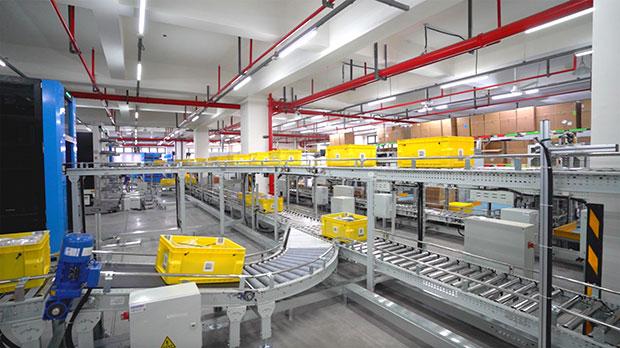As the demand for cross-border e-commerce continues to rise, efficient warehousing and distribution services are becoming more important than ever. WINIT, a company facing the challenges of storing and handling a large number of SKUs owned by different merchants, chose Hai Robotics to automate its fulfilment operations.
 In late 2021, WINIT deployed 100 autonomous case-handling robots (ACRs) from Hai Robotics in its warehouse near Birmingham in the central U.K. With the ACRs moving smoothly in the facility to help workers pick and sort goods, the warehouse’s efficiency has tripled or quadrupled, handling volumes of up to 50,000 pieces daily.
In late 2021, WINIT deployed 100 autonomous case-handling robots (ACRs) from Hai Robotics in its warehouse near Birmingham in the central U.K. With the ACRs moving smoothly in the facility to help workers pick and sort goods, the warehouse’s efficiency has tripled or quadrupled, handling volumes of up to 50,000 pieces daily.
Hai Robotics provided a customised plan for WINIT, with 120,000 storage locations and shelving height of 4.3 m in a 10,000 sqm warehouse in Tamworth, Staffordshire. The company rapidly deployed 100 ACRs, HAIPICK A42, and 16 On-conveyor Picking Workstations in the warehouse. With automated storage and retrieval functions, the average efficiency reaches 450 cases per hour, addressing WINIT’s requirements of high storage density, goods-handling accuracy, and operational efficiency.
With its flexible, scalable, and cost-effective solutions, Hai Robotics helps businesses like WINIT to achieve greater operational efficiency, especially in the e-commerce sector. Hai Robotics’ ACR systems are designed to meet the specific needs of 3PL, apparel and retail, e-commerce, and groceries, among other industries. Compared to traditional automation solutions and logistic service providers employing a human labor force, Hai Robotics’ ACR systems can exponentially increase operational efficiency, reduce implementation time, and save costs.
How ACR System is changing the warehouse returns process
Returns processing is an essential part of the supply chain that can significantly impact a company’s bottom line. The process is essential as it maintains an efficient flow of goods, reduces costs, creates value, decreases risk, and completes the product life cycle. However, handling returns can be a challenging task, particularly for warehouses and distribution centres, as it involves picking, sorting, and storage processes that can be time-consuming, expensive, and error-prone.
To address this challenge, companies are turning to Autonomous Case-handling Robot (ACR) systems to optimise returns handling, keeping costs low and operations effective. ACR systems can significantly maximise efficiency and obtain financial benefits by streamlining the picking, sorting, and storage processes of returned items. Faster processes mean a higher turnover of returned items, reducing the time a product stays on a shelf, maximising picking and storage, and reducing picking errors.
One company that has leveraged ACR systems to enhance its returns process is JNBY, a leading designer brand based in China. The company handles both B2B and B2C returns in its warehouse with a total area of 40,000 m², consisting of 5 floors, with ACR systems implemented on the 4th floor. Before automation, the company handled returns manually, including putaway, picking, and sorting processes. In this manual operation, 30 full-time employees (FTEs) were needed for putaway and 30 FTEs for picking.
After implementing the ACR system, operators only needed to put the returned items into a tote, and that’s it. Totes are automatically transported to a HAIPORT-powered workstation for putaway. With ACR systems, the putaway is entirely autonomous, and the picking process requires only 13 operators at the workstations. The solution features the HAIPORT-powered workstation, a one-stop case-handling goods-to-person solution introduced to the market in 2020 that enables simultaneous loading and unloading of totes in just seconds. The HAIPORT loads up to 8 totes onto the ACR robot’s trays and puts them away into storage, increasing picking efficiency by up to two times for each workstation.
The ACR system also allows for direct inbound putaway and storage, meaning that once items are put on the totes, ACRs do all the work intelligently. The goods-to-person robots put away or store the tote intelligently without the sorting process required, increasing comprehensive efficiency by 100 times. Another significant advantage is that the customer could continue to use their existing WMS system, with the HaiQ ESS system integrating seamlessly and allowing for intelligent sorting, handling, and storage of totes.
The ACR system’s flexibility enables ACR robots, in many cases, to use the client’s existing totes, and shelves can sometimes be reused and integrated with the ACR system. In addition, there are no single points of failure by using robots, which means higher uptime and lower maintenance costs.
The benefits of the ACR system extend beyond cost savings and increased efficiency. Warehouses worldwide face a major shortage of skilled labour due to the rising demand for logistics services. The potential for robots to fill the gap is big, and the demand is also significant. With the ACR system, labour demand decreased from 60 FTEs dedicated to returns handling and picking before automation to 13 FTEs after automation, allowing the company to deal with labour shortages while reducing costs. Manual putaway of returns is slow, and a slow return inventory cycle means waste and overstock of return goods during peaks.
Experience ACR systems at LogiMAT – Stand 6A51.




Comments are closed.